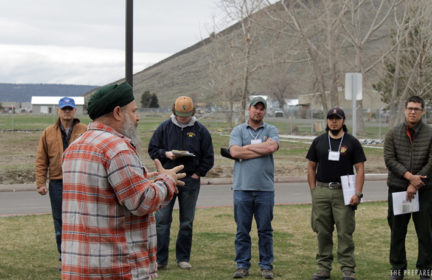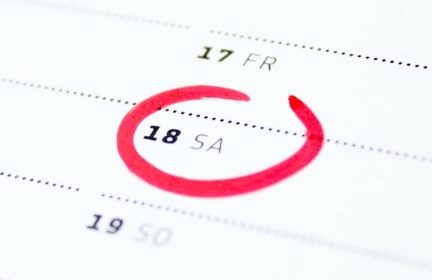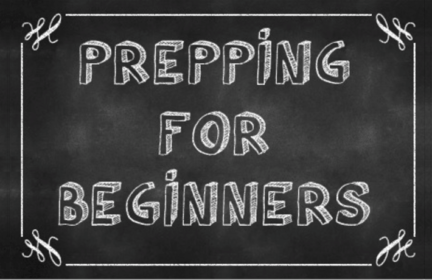Complete preparedness and the importance of inspection, maintenance, repair and replacement of items
Here’s a few examples of what can happen if preppers don’t practice routine inspection, maintenance, repair and replacement of their items.
An emergency alert is issued. You and your family, which includes two young children under seven years of age and a six month old infant are ordered to evacuate immediately.
You are prepared and grab your BOB’s and other gear and load the family into the vehicle in record time. You don’t make it out of the driveway because you have a flat tire. When you attempt to change your flat tire, you discover that your spare is also flat.
A spare tire should be checked for inflation at least twice a year.
I do the “trucker’s walk” around my vehicle each and every time I drive it. I walk around my vehicle and check for fluid leaks, anything hanging down or situated below the vehicle, the tires and their condition.
I also visually check for small animals or children crouched down behind the vehicle who may be playing or hurt. This happened to someone I knew. There was a child behind his truck and he didn’t check. The two year old boy died when he backed over him. The child was in his blind spot.
Lights and their function are checked regularly, at least once per month. It would be more often, once a week, if I drove more frequently.
If you are alone, you can check the lights yourself by aiming them at night against your house or other building. You should be able to see if your head lights are on or off, the high beams work, and if the turn signals, hazard lights and brake lights function properly.
I keep a couple of spare headlights in case one burns out and fuses for other vehicle function.
Here’s another example of not paying attention to routine maintenance.
You go to work one day in late August and find out that your company is downsizing. You are now unemployed. You have a mortgage and other bills to pay.
When you relay the news to your family, you discover that all your children have dental problems, require dental appointments and will need dental work done. You are also told that the children require footwear before school starts in a few weeks. Additionally, your oldest needs a new winter coat and glasses.
All of this happens just after you bought new living room furniture. You have less than three hundred dollars in a savings account and no emergency fund to handle these urgent family expenses in a time of reduced income.
Preparedness can seem like the pursuit and acquisition of a long list of items.
Becoming prepared is much more than acquiring the items. It is about how you look after them once you get them and how you manage the replacement of them.
It extends further into the care of possessions that we don’t consider as prep items, but are items we need or want as part of our quality of life.
In order to care properly for your possessions, it helps to have a routine for inspection. It helps more if you develop the habit of noticing signs of wear or need for repair or replacement of your items.
You need to know what to look for that could be sign of a problem and that takes all your senses.
Visually, it can be icicles hanging off your roof, signalling an ice dam that needs to be addressed. It can be something dripping beneath your vehicle’s front end that needs to be checked.
I routinely check my canned goods for signs of bulging cans or rusting cans.
Sometimes, it can be a sound of a fridge motor not running right or the noise your brake pads make when they begin to wear.
I check the plumbing under my kitchen sink and bathroom vanity every time I open the cabinet doors.
You also check by touch. If the walls in the house feel tacky or damp, then you need a dehumidifier to prevent mould.
If you run your hands along the inside of your tires and feel a bulge, then you know the tire is failing, can blow out and needs to be replaced immediately.
Smell can tell us if there is mould in the house or a gas leak. Certain smells can indicate failing electrical wiring.
I have a routine for repair and maintenance and a trained eye that notices issues outside of my routine inspections.
I also plan for the replacement of items by understanding the usual life span of each of them.
This part of preparedness is applicable to everyone who preps regardless of whether you live in an apartment or own a home on an acreage.
Recently, I made another list of things in and around my home and property that need to be addressed. This list includes clothing and footwear. Those items were put on the list as I noticed them while I worked on chores in and around the house.
Some of the items that made the list weren’t that old, but they were what I refer to as “bad buys.” For example, I purchased an expensive pair of winter boots for my husband. They are a very well known brand and had excellent reviews. A good fit in footwear is a challenge for his feet and these boots fit great and were comfortable.
The boots started to fail after the first year he wore them. The boots failed just after the warranty ended. When I searched for information, I was shocked to find that this company had customers with similar complaints. Of more concern, was the poor response from the company. So much for relying on glowing reviews.
Their product was failing due to shoddy third party outsourcing. The chance to fix the problem failed at the front lines of their customer service and their poorly designed software.
Complaints containing certain key words or with time lines indicating an early failure of their product should have triggered a referral and further action higher up the corporate ladder. They could have dealt swiftly with a supplier issue and salvaged their reputation and customer base.
I used Shoo-goo to repair them, and he can wear them as a pair of chore boots. But now, I have to research and replace them with a new pair of winter boots suitable for our extreme climate, his size 15 feet and our budget.
What if the SHTF and that was all he had for a long period of time? He would be entering a crisis without sound footwear and perhaps no chance of replacing the boots for some time. Many of our parts or actual products in North America are outsourced. It doesn’t take much to throttle that supply chain.
Footwear is a major necessity and an equally important prep item. This is an example of how we may think we have a certain amount of time before the new item will need to be replaced, but in reality the time frame is much shorter.
I have had the same experience with a brand new washer and dryer set. I still have the dryer, but the washer failed just after the one year warranty expired.
I knew someone who worked in an agricultural machine production plant. The parts on those very expensive pieces of equipment were engineered to fail after a certain time, often in three years.
Deliberately engineering the premature failure of items, in whole or in part, is unfair considering what we pay for these items. It is now a part of life that we need to be aware of, especially as preppers who organize and put items away for future need.
It wasn’t always like this. There was a time when items were built to last.
My parent’s were strict about the care and maintenance of our property, possessions and personal items. I was raised to understand that everything would last longer if you treated it properly and with care.
I was also taught the importance of organization and to be aware of items would be outgrown or worn out. I grew up in a household where certain items were stored in anticipation of replacement.
We were able to farm with old equipment because Dad practised routine inspection and maintenance of his equipment.
As in the fable of the ants and the grasshopper, other farmers played the role of the grasshopper at the end of harvest as they lingered over coffee and pie at the local coffee shop.
Dad played the role of ant, and continued to labor long after harvest to ensure that the equipment was maintained, in good repair and ready for next spring. Even in winter, he repaired anything that wasn’t working correctly.
His care extended to every part of our farm and home. He examined the house and outbuildings to see if something needed repair. He walked endless miles on our land to check fence lines. This was in addition to twice daily milking and care and cleaning of our cows, barn and dairy equipment.
Routine repair and maintenance can seem like boring chores and mundane tasks. Let’s face it, checking, cleaning and repairing things aren’t generally considered fun. Now, with early failure to consider, this aspect of prepping has become even more important.
New living room furniture doesn’t happen without an emergency fund. Throw a blanket or a slip cover on the sofa and teach your family to treat items more gently.
Dental, optical and any other medical needs should be written out and organized. If you know that the family has dental checks done in August, then you also know that is a month for potential dental expenses.
If you are putting money away each month to cover possible dental expenses, then you are prepared for them.
Expenses such as clothing and footwear for children should never be a “surprise.” It is understood children need footwear and clothing replaced more rapidly due to their growth.
A smart shopper and prepper recognizes the opportunity for thrift store shopping. You can find clothing and footwear in excellent condition for all ages.
I have seen teens happily shop at thrift stores. There is always some kind of retro fad happening. They also seem to enjoy the originality of thrift store shopping, as well as the social and environmental contribution that comes with it. Good causes are supported and perfectly good clothing doesn’t end up in landfill.
In a financial crisis such as job loss, pride is a vulnerability. When the tags are off the garment who really knows how old a garment is or where you bought it from unless you tell them?
A budget binder is a must for routine financial management and maintenance. For privacy and security reasons, there is no way I will ever rely on computerized record keeping again.
A binder is tangible and can’t be ignored. I see it on my desk as I write. I can grab it for a family finance meeting if there is something that needs to be addressed.
I write out budget sheets for two future years and I keep two years of past monthly financial data. The loose leaf sheets are enclosed in page protectors for longevity and also hold additional information that is relevant to future expenses.
The monthly budget sheets itemize income, savings and regular monthly expenses. Amounts that are variable like utility bills are forecast in pencil and then entered in ink once the amounts are confirmed.
Based on forecasted income and expenses, I have a reasonable understanding of our disposable income. Annual expenses can easily be repeated in the future year sheets. I can slot projects or swap them on the fly if necessary because the budget information is well organized and accessible.
Beneath the financial information is a record of medical appointments and vehicle or home repair and maintenance and any associated costs.
A budget is a guide. On the back of each monthly budget sheet, I record every cent spent in this household. I balance to the penny because hackers will test bank accounts by taking small amounts to see if you pay attention.
I note the amount, where it was purchased, a short list of the item(s) and any important sale information for future reference when planning future shopping. I can look back at each month and see exactly where our money went for groceries, clothing, personal items and spot trends or problems.
This process may seem involved and time consuming. It isn’t. It takes little time to keep an ongoing record. I refer to these records frequently for a variety of reasons. They are invaluable to the inspection, repair, replacement and maintenance of a huge number of items in my household and property.
Other items must be factored for replacement. What about shingles? Roofs must be re-shingled every so many years. That includes underlay, ice guard (if you are in a cold climate) and installation.
Most communities only allow a certain number of shingle layers before the roof has to be stripped completely of shingles before it can be re-shingled. This makes sense because after a while the roof would not be sound if shingles just continued to pile up in layers.
When I did my roof five years ago, I paid extra to have it stripped clean of shingles. I didn’t need to do it that way. I wasn’t at the limit for layers. But I chose to do the best maintenance by having the roof done from the base up.
The roofers checked for any pieces of plywood that need to be replaced. There was one small piece. Then they re-shingled with the latest materials to prevent water infiltration and also ice-guard. I chose excellent quality shingles and made sure the roofers were certified to install that type of shingle. They did an excellent job and now, I have a roof that will last much longer before needing more maintenance.
I could have gone a cheaper route, but a roof is a huge part of the protection of a home. There is no way I will skimp on that cost or the quality of materials and workmanship.
I find it amazing that people see their roofs every day and tolerate the condition of them. Imagine a shoddy roof in a major storm. How long might it last in a natural or financial disaster? There could be a chain reaction of damage done that will cost more than if the roof was properly done in the first place.
A fully prepared household doesn’t just buy preparedness related items and stash them away. They routinely inspect, maintain, replace and repair the items that they will need to count on in a disaster.
They do the same thing for their home, property and other items that are not prep specific, but are also part of their ability to survive.
It can be overwhelming for those who don’t currently practice this, but with a bit of organization and time invested, it can become easy to do and just another aspect of prepping.
When was the last time you checked your tires for wear or if they were properly inflated? Did you get the brakes fixed when you heard the sound of brake shoes starting to squeal as you braked?
Have you organized regular replacement of your children’s clothing and footwear?
How old is the food and water in your bug out bag?
What about those loose boards in the fence or the unreliable security camera that needs replacement?
The time to notice and do something about it is now and like other aspects of prepping, it is time well invested.
-
Comments (4)
-


